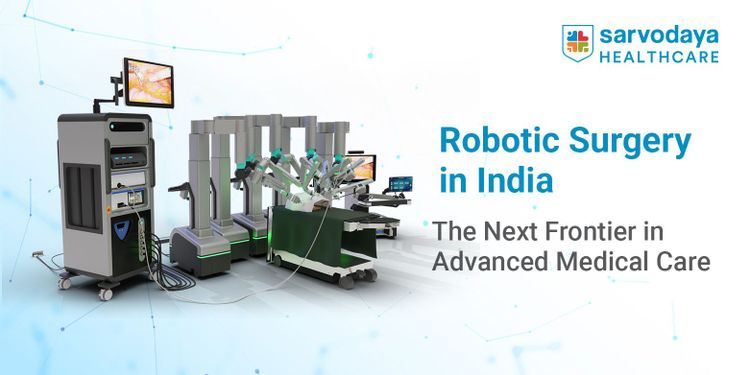Technology has played a vital role in transforming healthcare over the past few decades. From advanced imaging techniques to artificial intelligence in diagnostics, every innovation has brought new possibilities. Among these, robotic surgery stands out as one of the most revolutionary advancements in modern medical science. It combines the precision of robotics with the expertise of skilled surgeons, creating a safer, more efficient, and patient-friendly approach to surgery.
In this blog, we explore what robotic surgery is, how it works, and the reasons why it is rapidly gaining popularity across the globe.
Understanding Robotic Surgery
Robotic surgery is a form of minimally invasive surgery performed using computer-assisted robotic systems controlled by a highly trained robotic surgeon. A typical example of this technology is AI-Powered Smart Surgical Robotone of the most widely used robotic platforms worldwide. It translates the surgeon’s hand movements into precise actions of miniature surgical instruments while providing a high-definition 3D view of the surgical site.
Some of the main features that distinguish robotic surgery include:
- Enhanced Precision: Robotic arms can make movements smaller and steadier than a human hand.
- Better Visibility: Surgeons view magnified, high-definition 3D images during the surgery.
- Improved Ergonomics: Surgeons operate from a console, reducing physical strain and fatigue.
Read More- Robotic Surgery: Revolutionising Modern Healthcare with Precision and Safety
The Workings of Robotic Surgery
Robotic surgery does not replace the surgeon but rather serves as an advanced tool that amplifies their control and accuracy.
A robotic surgeon performs the surgery from a console situated near the patient. The system consists of three main components – the surgeon’s console, robotic arms, and a high-definition 3D vision system.
Here is how the process works step by step:
- The surgeon controls the robotic arms using hand and foot movements at the console.
- These commands are then translated into precise, scaled-down movements of the surgical instruments attached to the robotic arms.
- The 3D vision system magnifies the operative field, allowing the surgeon to view even the smallest anatomical structures in detail.
- Every movement is smooth and tremor-free, ensuring minimal damage to surrounding tissues.
Major Types of Robotic Surgeries
Robotic surgeries are now used across multiple medical specialities, offering patients safer and faster treatment options.
Below are some of the most common surgeries where robotic assistance is transforming outcomes:
- Robotic Cancer Surgery: Used for treating cancers of the prostate, lungs, cervix, and colon. The precision of robotic arms enables surgeons to remove tumours with minimal damage to nearby tissues.
- Robotic General Surgery: Applied in surgeries like gallbladder removal, hernia repair, and colorectal surgery. It provides enhanced dexterity and shorter recovery times compared to traditional open surgery.
- Robotic Gynaecologic Surgery: Commonly performed for hysterectomy, endometriosis, and fibroid removal. It ensures minimal scarring, less pain, and faster postoperative recovery.
- Robotic Urology Surgery: Ideal for prostatectomy, kidney surgery, and bladder reconstruction. It allows for the delicate handling of tissues and reduces complications in sensitive areas.
Patients seeking precision-based care can now access robotic surgery under expert supervision, making it one of the most sought-after treatment options for various conditions.
Key Benefits of Robotic Surgery
Compared with traditional open or laparoscopic surgeries, the benefits of robotic surgery are extensive.
Here are some of the significant advantages that make this form of minimally invasive surgery highly preferred:
- Unmatched Precision: Robotic systems allow surgeons to make delicate, precise movements that are not possible with the human hand alone.
- Smaller Incisions and Less Scarring: The minimally invasive approach results in smaller cuts, which reduces scarring and promotes better cosmetic outcomes.
- Reduced Blood Loss: The precision of robotic instruments minimises bleeding and the need for transfusions.
- Shorter Hospital Stays: Patients often go home sooner due to reduced trauma and faster healing.
- Lower Risk of Complications: The technology minimises the margin of human error, leading to fewer infections and surgical complications.
- Improved Postoperative Comfort: Reduced pain and faster recovery allow patients to return to their daily lives much earlier.
Robotic Surgery Recovery Time and Postoperative Care
The typical robotic surgery recovery time depends on the type of operation and the patient’s overall health, but most people experience noticeably faster healing and fewer complications.
Below are a few aspects that influence the recovery process:
- Type of Surgery: Surgeries like robotic urology surgery or robotic gynaecologic surgery often allow patients to resume normal activities within two to three weeks.
- Patient’s Health Condition: Patients in good health tend to recover faster and with less discomfort.
- Postoperative Care: Following the surgeon’s instructions regarding rest, wound care, and physiotherapy ensures smooth healing.
- Follow-Up Visits: Regular check-ups allow doctors to monitor recovery and address any minor concerns early.
The Future of Robotic Surgery in India and Beyond
The future of robotic surgery looks exceptionally promising as innovation continues to shape how surgeries are performed. Globally, there is an increasing shift towards automation, precision, and patient-centred care, and robotic surgery sits at the heart of this evolution.
Artificial intelligence and advanced imaging technologies are now being integrated with robotic systems to enhance decision-making and accuracy. Surgeons are also exploring telesurgery, where operations can be conducted remotely with real-time monitoring. These advancements not only improve surgical outcomes but also make complex surgeries more accessible to patients across the world.
Conclusion
The advent of robotic surgery has marked a turning point in modern medicine, offering patients greater precision, faster recovery, and improved overall outcomes. By combining human expertise with robotic accuracy, this innovation continues to redefine how we approach surgical treatment.
At the heart of this transformation, Sarvodaya Hospital, Faridabad, stands out as one of the leading healthcare institutions offering state-of-the-art robotic surgery facilities. The hospital provides access to expert robotic surgeons and advanced technology, ensuring safer and more effective outcomes for patients. Whether it’s robotic cancer surgery, robotic urology surgery, or robotic gynaecologic surgery, Sarvodaya’s comprehensive care approach ensures that each patient receives tailored treatment and support throughout their recovery journey.
If you are experiencing persistent pain or have been advised surgery, take the first step towards advanced care and book an appointment now at Sarvodaya Hospital, Faridabad.

















